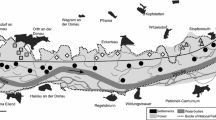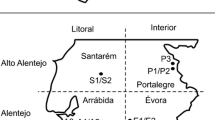Abstract
Succession has a strong influence on species diversity and composition of semi-natural open terrestrial ecosystems. While several studies examined the effects of succession on butterflies in grassland and forest ecosystems, the response of heathland butterflies to succession had not been investigated so far. To address this issue we sampled butterfly abundance and environmental parameters on the Baltic island of Hiddensee (NE Germany) along a gradient of coastal heathland succession from grey dunes to birch forest. Our results provide evidence that succession of coastal heathland has a strong influence on butterfly diversity, abundance, and species composition. Thereby grass and tree encroachment present the main threats for heathland butterflies. Diversity and abundance of butterflies were highest in shrub-encroached heath directly followed by early stages of coastal heathland succession (dwarf-shrub heath, grey dune). Both observed threatened species (Hipparchia semele, Plebeius argus) were negatively affected by succession: abundance decreased with increasing vegetation density (both species) and grass cover (P. argus); consequently, the two later successional stages (shrub, birch forest) were not occupied. Our findings highlight the importance of the preservation of early stages of coastal heathland succession for endangered butterfly species. For coastal heathland management we therefore suggest to maintain early successional stages by sheep grazing, mowing or, in case of high nutrient contents, intensive techniques such as sod-cutting or choppering. To a lower extend shrub-encroached sites should also be present, which might be beneficial for overall species richness.





Similar content being viewed by others
References
Asher J, Warren M, Fox R, Harding P, Jeffcoate G, Jeffcoate S (2001) The millennium atlas of butterflies in Britain and Ireland. Oxford University Press, Oxford
Balmer O, Erhardt A (2000) Consequences of succession on extensively grazed grasslands for central European butterfly communities: rethinking conservation practices. Conserv Biol 14:746–757
Baur B, Cremene C, Groza G, Rakosy L, Schileyko AA, Baur A, Stoll P, Erhardt A (2006) Effects of abandonment of subalpine hay meadows on plant and invertebrate diversity in Transylvania, Romania. Biol Conserv 132:261–273
Borchard F, Schulte AM, Fartmann T (2013) Rapid response of Orthoptera to restoration of montane heathland. Biodivers Conserv 22:687–700
Bräu M, Bolz R, Kolbeck H, Nummer A, Voith J, Wolf W (2013) Tagfalter in Bayern. Ulmer, Stuttgart
Britton AJ, Pakeman RJ, Carey PD, Marrs RH (2001) Impacts of climate, management and nitrogen deposition on the dynamics of lowland heathland. J Veg Sci 12:797–806
Buchholz S, Hannig K, Schirmel J (2013) Losing uniqueness—shifts in carabid species composition during dry grassland and heathland succession. Anim Conserv 16:661–670
Dennis RLH (2010) A resource-based habitat view for conservation. Butterflies in the British landscape. Wiley, Chichester
Dennis RLH, Shreeve TG, Van Dyck H (2003) Towards a functional resource-based concept for habitat: a butterfly biology viewpoint. Oikos 102:417–426
Ebert G, Rennwald E (eds) (1991a) Die Schmetterlinge Baden-Württembergs. Vol 1, Tagfalter I. Eugen Ulmer, Stuttgart
Ebert G, Rennwald E (eds) (1991b) Die Schmetterlinge Baden-Württembergs. Vol 2, Tagfalter II. Eugen Ulmer, Stuttgart
EC (European Commission) (2007) Interpretation manual of European Union habitats—EUR27. European Commission, DG Environment, Brussels
Fartmann T, Krämer B, Stelzner F, Poniatowski D (2012) Orthoptera as ecological indicators for succession in steppe grassland. Ecol Indic 20:337–344
Fartmann T, Müller C, Poniatowski D (2013) Effects of coppicing on butterfly communities of woodlands. Biol Conserv 159:396–404
García-Barros E, Fartmann T (2009) Butterfly oviposition: sites, behaviour and modes. In: Settele J, Shreeve T, Konvička M, Van Dyck H (eds) Ecology of butterflies in Europe. Cambridge University Press, Cambridge, pp 29–42
Gimingham CH (1992) The lowland heathland management handbook. English Nature Science, Peterborough
Greatorex-Davies JN, Sparks TH, Hall ML, Marrs RH (1993) The influence of shade on butterflies in rides of coniferised lowland woods in southern England and implications for conservation management. Biol Conserv 63:31–41
Heil GW, Diemont WH (1983) Raised nutrient levels change heathland into grassland. Vegetatio 53:113–120
Karsholt O, Razowski W (1996) The Lepidoptera of Europe: a distributional checklist. Apollo Books, Stentrup
Krämer B, Poniatowski D, Fartmann T (2012) Effects of landscape and habitat quality on butterfly communities in pre-alpine calcareous grasslands. Biol Conserv 152:253–261
Kruess A, Tscharntke T (2002) Grazing intensity and the diversity of grasshoppers, butterflies, and trap-nesting bees and wasps. Conserv Biol 16:1570–1580
Leopold P (2007) Larvalökologie der Rostbinde Hipparchia semele (Linnaeus, 1758; Lepidoptera, Satyrinae) in Nordrhein-Westfalen. Die Notwendigkeit raumzeitlicher Störungsprozesse für den Arterhalt. Abh Westf Mus Naturkde 69:1–146
Littlewood NA, Pakeman RA, Woodin SJ (2006) The response of plant and insect assemblages to the loss of Calluna vulgaris from upland vegetation. Biol Conserv 128:335–345
Maes D, Bonte D (2006) Using distribution patterns of five threatened invertebrates in a highly fragmented dune landscape to develop a multispecies conservation approach. Biol Conserv 133:490–499
Maes D, Ghesquiere A, Logie M, Bonte D (2006) Habitat use and mobility of two threatened coastal dune insects: implications for conservation. J Insect Conserv 10:105–115
Magurran AE (2004) Measuring biological diversity. Blackwell, Oxford
Mantilla-Contreras J, Schirmel J, Zerbe S (2012) Influence of soil and microclimate on species composition and grass encroachment in heath succession. J Plant Ecol 5:249–259
Marini L, Fontana P, Battisti A, Gaston KJ (2009) Response of orthopteran diversity to abandonment of semi-natural meadows. Agric Ecosyst Environ 132:232–236
McCune B, Grace JB (2002) Analysis of ecological communities. MjM Software Design, Gleneden Beach
Mecklenburg-Vorpommern U (ed) (2003) Die Naturschutzgebiete in Mecklenburg-Vorpommern. Demmler, Schwerin
Munguira ML, García-Barros E, Martín Cano J (2009) Butterfly herbivory and larval ecology. In: Settele J, Shreeve T, Konvička M, Van Dyck H (eds) Ecology of butterflies in Europe. Cambridge University Press, Cambridge, pp 43–54
Öckinger E, Eriksson AK, Smith HG (2006) Effects of grassland abandonment, restoration and management on butterflies and vascular plants. Biol Conserv 133:291–300
Pollard E (1977) Method for assessing changes in abundance of butterflies. Biol Conserv 12:15–134
Pollard E, Yates TJ (1993) Monitoring butterflies for ecology and conservation. Chapman and Hall, London
Provoost S, Jones MLM, Edmondson SE (2009) Changes in landscape and vegetation of coastal dunes in northwest Europe: a review. J Coast Conserv 15:207–226
Ravenscroft NOM (1990) The ecology and conservation of the silver-studded blue butterfly Plebejus argus L. on the sandlings of East Anglia, England. Biol Conserv 53:21–36
R Development Core Team (2011) R: a language and environment for statistical computing. R Foundation for Statistical Computing, Vienna
Reinhardt R, Bolz R (2011) Rote Liste und Gesamtartenliste der Tagfalter (Rhopalocera) (Lepidoptera: Papilionoidea et Hesperioidea) Deutschlands. Natursch Biol Vielfalt 70(3):167–194
Remke E, Brouwer E, Kooijman A, Blindow I, Esselink H, Roelofs JGM (2009a) Even low to medium nitrogen deposition impacts vegetation of dry, coastal dunes around the Baltic Sea. Environ Pollut 157:792–800
Remke E, Brouwer E, Kooijman A, Blindow I, Roelofs JGM (2009b) Low atmospheric nitrogen loads lead to grass encroachment in coastal dunes, but only on acid soils. Ecosystems 12:1173–1188
Roem WJ, Klees H, Berendse F (2002) Effects of nutrient addition and acidification on plant species diversity and seed germination in heathland. J Appl Ecol 39:937–948
Rose RJ, Webb NR, Clarke RT, Traynor CH (2000) Changes on the heathlands in Dorset, England, between 1987 and 1996. Biol Conserv 93:117–125
Salz A, Fartmann T (2009) Coastal dunes as important strongholds for the survival of the rare Niobe fritillary (Argynnis niobe). J Insect Conserv 13:643–654
Schirmel J, Buchholz S (2011) Response of carabid beetles (Coleoptera: Carabidae) and spiders (Araneae) to coastal heathland succession. Biodivers Conserv 20:1469–1482
Schirmel J, Mantilla-Contreras J, Blindow I, Fartmann T (2011) Impacts of succession and grass encroachment on heathland Orthoptera. J Insect Conserv 15:633–642
Settele J, Steiner R, Reinhardt R, Feldmann R (2005) Schmetterlinge: die Tagfalter Deutschlands. Ulmer, Stuttgart
Skórka P, Settele J, Woyciechowski M (2007) Effects of management cessation on grassland butterflies in southern Poland. Agric Ecosyst Environ 121:319–324
Sparks TH, Greatorex-Davies JN, Mountford JO, Hall ML, Marrs RH (1996) The effects of shade on the plant communities of rides in plantation woodland and implications for butterfly conservation. For Ecol Manag 80:197–207
Sundermeier A (1998) Methoden zur Analyse der Vegetationsstruktur. In: Traxler A (ed) Handbuch des vegetationsökologischen Monitorings. Teil A: Methoden. Umweltbundesamt, Wien, pp 123–158
Tews J, Brose U, Grimm V, Tielbörger K, Wichmann MC, Schwager M, Jeltsch F (2004) Animal species diversity driven by habitat heterogeneity/diversity: the importance of keystone structures. J Biogeogr 31:79–92
Thomas CD (1985) The status and conservation of the butterfly Plebejus argus L. (Lepidoptera: Lycaenidae) in North West Britain. Biol Conserv 33:29–51
Venables WN, Ripley BD (2002) Modern applied statistics with S, 4th edn. Springer, New York
WallisDeVries MF, Raemakers I (2001) Does extensive grazing benefit butterflies in coastal dunes? Restor Ecol 9:179–188
WallisDeVries MF, Van Swaay C (2006) Global warming and excess nitrogen may induce butterfly decline by microclimatic cooling. Glob Chang Biol 12:1620–1626
WallisDeVries MF, Van Swaay CAM, Plate CL (2012) Changes in nectar supply: a possible cause of widespread butterfly decline. Curr Zool 58:384–391
Warren MS (1985) The influence of shade on butterfly numbers in woodland rides, with special reference to the wood white Leptidea sinapis. Biol Conserv 33:147–164
Webb NR (1998) The traditional management of European heathlands. J Appl Ecol 35:987–990
Wheeler B (2010) lmPerm: permutation tests for linear models. R package version 1.1-2. http://CRAN.R-project.org/package=lmPerm
Wünsch Y, Schirmel J, Fartmann T (2012) Conservation management of coastal dunes for Orthoptera has to consider oviposition and nymphal preferences. J Insect Conserv 16:501–510
Zuur AF, Ieno IN, Walker NJ, Saveliev AA, Smith GM (2009) Mixed effects models and extensions in ecology with R. Springer, Berlin
Zuur AF, Ieno EN, Elphick CS (2010) A protocol for data exploration to avoid common statistical problems. Methods Ecol Evol 1:3–14
Acknowledgments
We thank Jasmin Mantilla-Contreras for help with the field work and the national park ‘Vorpommersche Boddenlandschaft’ for the permission to conduct the study in the protected area. The study was partly funded by the ‘Bauer-Hollmann-Stiftung’. Moreover, we a grateful to two anonymous referees for valuable comments on an earlier version of the manuscript.
Author information
Authors and Affiliations
Corresponding author
Appendix
Appendix
See Table 4.
Rights and permissions
About this article
Cite this article
Schirmel, J., Fartmann, T. Coastal heathland succession influences butterfly community composition and threatens endangered butterfly species. J Insect Conserv 18, 111–120 (2014). https://doi.org/10.1007/s10841-014-9619-7
Received:
Accepted:
Published:
Issue Date:
DOI: https://doi.org/10.1007/s10841-014-9619-7




